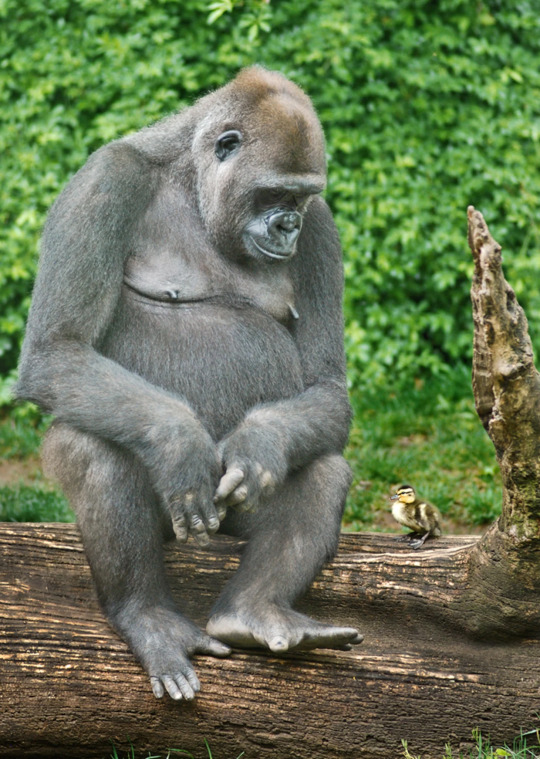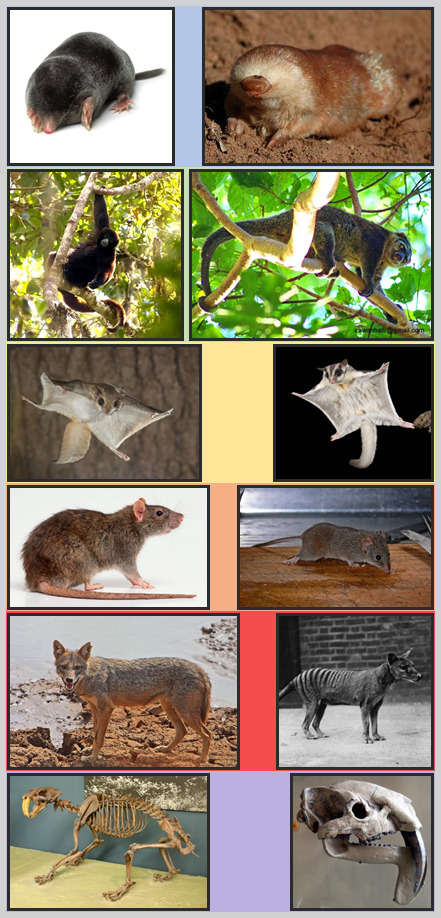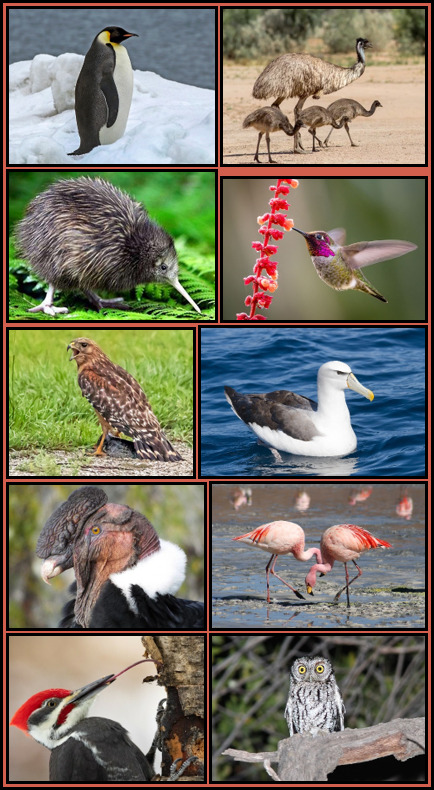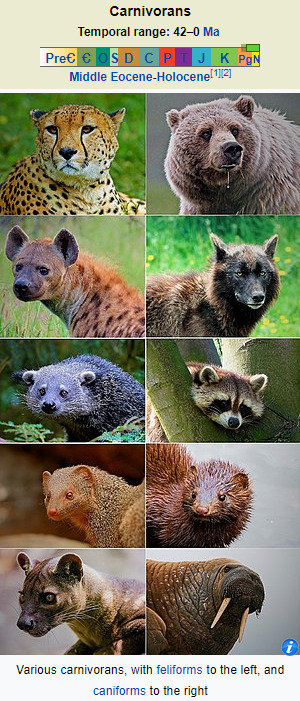Text

I think most people are aware of the fact that humans are related to other primates such as chimps, gorillas, mandrills and probably even Curious George. As a matter of fact, humans ARE primates, which means we share a common ancestor with all other primates. The order Primate includes many species other than just humans and animals that we usually call "monkeys", it also includes lemurs and some other minor families.
However, what I was curious to know was what animals are the most closely related to humans after the primates. To find out, we need to go up the ranks in our phylogenetic tree. As seen on the image on top, primates are part of the mirorder (like an order, but bigger) Primatomorpha, which includes the order Dermoptera (yes, Greek nerds, this means something along the lines of "wing skin"). The order Dermoptera consists entirely of colugos, which are also known as flying lemurs. Despite their name, they are not lemurs and despite their appearance, they are not flying squirrels. They just happen to also be equipped with a patagium (the skin membrane they use to glide) due to convergent evolution. While this is surely interesting, colugos are quite obscure animals and I was looking for a group of animals that would be more "commonly known", even if a bit less related to humans.
We can go even higher up in our phylogenetic tree and see that Primatomorpha are part of the grandorder (like a mirorder, but even bigger) Euarchonta and have a sister order, Scandentia. Animals in the order Scandentia are referred to as "tree shrews", but again, the name is misleading because while they are indeed arboreal, they are not shrews. The image above has one example of these creatures, a tupaia, and while they are cute and all, they are still not what I would call a "commonly known animal". Also, note that the position of the order Scandentia in the evolutionary tree is actually debatable as some researchers place them as a sister clade* to the Glires.
Going one more rank up in our phylogenetic tree, we see that Euarchonta are part of the superorder (like a grandorder, but bigger, you get the idea) Euarchontoglires, which includes the clade Glires. Within this clade are found the orders Lagomorpha and Rodentia, which are both comprised of very well known animals, such as rabbits and rats. I think it's pretty cool to think that those animals are quite closely related to primates, and therefore, to humans. Probably this is why they are (sadly) used for animal testing of medicine and cosmetics, although they are also probably used because of economical reasons.
* I will one day make a post about this word, it's actually pretty interesting.
#animals#primates#humans#colugo#order#clade#dermoptera#primatomorpha#scandentia#euarchonta#euarchontoglires#glires#phylogenetic tree#phylogeny
8 notes
·
View notes
Text

This has to be my favorite picture on the internet involving animals. This gorilla made a friend.
There's no need for a long post.
9 notes
·
View notes
Photo
Reality can somtimes impress us much more than fiction and yet, our fertile and ambitious imagination still looks for more. In that yearning, we sometimes make up worlds of our own.
The image above presents an example of speculative evolution. This is a form of fiction focused on the hypothetical evolution of species in the distant future, often based on a particular driving narrative.
The poster showcases the (fictitious) evolution the "Amorphous shame", branching off from a long-tailed weasel population that ventured themselves inside the body of a (fictitious) gigantic beast.
This post was taken from the "Mystery Flesh Pit National Park" blog, which is dedicated to gathering memorabilia related to the National park built around (and inside) a gigantic beast that was found underneath southern USA. Go check it out, the worldbuilding is amazing and it's one of my favorite blogs on tumblr!

The curiously-named “Amorphous Shame” is a strange and highly unique animal found living within pockets of flesh inside the Mystery Flesh Pit. The name was earned by the appearance of the creatures which seemed to be living collections of loose organs. In reality, Amorphous Shames have simply been shaped by the forces around them, in much the same way that contemporary domestic dog breeds barely resemble their wolf ancestors.
#animals#speculative evolution#evolution#mystery flesh pit#flesh pit#fiction#national park#amorphous shame
3K notes
·
View notes
Text

The image above presents examples of "Convergent Evolution".
Convergent evolution is the case of two (or more) different species that share evolutionary traits that their common ancestor did not possess. In that way, it is sort of the opposite of divergent evolution. This phenomenon occurs when unrelated and distinct species were exposed to similar evolutionary pressures that favored the same traits.
Think of it as when two people independently come up with the same idea, because they were both trying to solve the same problem.
On the image above, each row compares two animals that converged into the same body "design". The animals to the left are placental animals and the animals to the right are marsupials. Millions of years ago, continental drift confined most marsupials to Australia and neighboring islands. With little to no competition from placental mammals, marsupials thrived on their isolated territory. Despite their significant differences, the need to fill similar ecological niches caused marsupials and placental animals to evolve in convergent ways.
1. "True" mole and Marsupial mole: Small, fusiform body with strong claws and extremely atrophied eyes. They are highly adapted for underground life.
2. Yellow-tailed woolly monkey and Bear cuscus: Medium-sized body with opposable thumbs and prehensile tail. They are adapted for an arboreal life.
3. Flying squirrel and Sugar glider: Small body, big tail (in proportion to their body) and sharp claws. These animals are also highly adapted for arboreal life. On top of this, they both boast the ability to glide between trees thanks to their patagium.
4. Rat and Yellow-footed antechinus: Not much to say, they both went for the small and cute vibe. They are also very good climbers.
5. Jackal and Thylacine: Medium sized predatory carnivores. Thylacines were the marsupial equivalent of wolves or wild dogs, but they went extinct relatively recently (first half of the 20th century).
6. Smilodon and Thylacosmilus: Convergent evolution is not only observable in extant species. These two extinct animals were large and strong top predators with long menacing canines. Thylacosmilus were the sprassodont* equivalent to what we call "sabre-tooth cats".
*Sprassodonts aren't exactly marsupials, but they are closely related.
83 notes
·
View notes
Text

In my previous post, I made reference to "Divergent evolution". This is the process through which organisms within a population (of the same species) take different evolutionary paths and become distinct species.
The previous post was about the divergent evolution of birds, which led to a diverse range of body types within the bird class. Birds are not the only group of animals that boasts such diversity, though.
Although they are not equipped with some extraordinary evolutionary feature (like flight), rodents have also become amazingly diverse. Divergent evolution has given origin a vast array of different body types within the order "Rodentia" (nerd term for "rodent").
The pictures above represent different body "designs" we can observe in rodents.
Patagonian Mara: While sitting, the hind legs of this rodent are contracted like those of a rabbit, but once they stand up to walk, Maras look more like a small deer. In fact, their toes are sort of clumped together, making their feet hoof-like. This allows the Mara to run at surprising speeds for their size (30-45 km/h). Because of their strong hind legs, they are also great jumpers.
Capybara: The biggest rodent in the world. They have a stocky bodies and graze on grass and aquatic plants. They tend to live close to bodies of water. Because of this, they have evolved slightly webbed feet.
Rat: A generalist omnivorous rodent, highly adapted for both rural and urban areas. Their small size and collapsible skeleton allows rats to get through very narrow gaps. This way, rats can crawl under doors, travel in sewage systems and hide in small holes behind walls.
Porcupine: They have a rather stocky body like capybaras and are nearly as big. Their quirk is the quills on their back that protect them against predators. They exist both in Afro-Eurasia (Old world porcupines) and in America (New world porcupines). In addition, New world porcupines have evolved to become arboreal.
Flying Squirrel: A rodent highly adapted for arboreal life. On top of this, they are able to glide from one tree to another with the aid of a skin membrane named "patagium".
Squirrel: A highly arboreal rodent. Their long tail helps them balance themselves on narrow branches and their sharp claws helps them get a strong grip on the bark of trees. On top of this, their strong hind legs allows them to leap over long distances.
Beaver: Besides the dams (that they build) that most people know them for, these rodents are very adapted for semi-aquatic life. They can remain underwater for up to 20 minutes, their read feet are webbed, and their flat tail works like a rudder when swimming. This makes them somewhat similar to otters (which are not rodents).
Jerboa: Similarly to kangaroos, their hind legs are elongated and adapted for hopping long distances at high speeds. Their tails are also very long to keep them in balance. Some species live in hot deserts and as such, have large ears which help them dissipate heat.
Groundhog: Ground rodents related to squirrels. Although they can be good climbers, they are better suited for terrestrial life and live in holes they dig underground.
Prairie dog: With a narrow, but elongated body, short ears and short tails, this rodent has adapted to a fossorial (burrowing) life style. They come out to the surface to feed as they are mainly herbivorous.
Naked mole-rat: Among all rodents, probably the best adapted to a fossorial life. They use their incisors to dig, so their lips have evolved in a way to remain closed while the incisors remain out. As they feed on tubers they find underground, they do not need to go to the surface. Their eyes have become atrophied, since they aren't needed in the dark underground tunnels.
0 notes
Text

All the animals pictured above are part of the class "Aves", which we refer to as "birds".
Birds present a case of the arrival of a new feature that is so revolutionary that it becomes a game changer. The "feature" in this case would be flight. (Note: Birds were not the first animals to fly; flying insects and flying reptiles were there before, but this post is about birds).
To make a parallel with human-made technology, we could think of the first device to ever use electromagnetic (such as radio) waves to transmit information. When it was just invented, this new device started off as a niche tool for very specific uses. However, the capacity to transfer information without the need of a wired connection was such a revolutionary feature that, given enough time, this technology was incorporated in a vast array of communication devices. Today, communication via electromagnetic waves are a central part of modern technology. GPS, Bluetooth, 5G, WiFi, remote controls, radios and cell phones are just a few examples of this.
Birds started off as a branch in the evolution of reptiles (dinosaurs, to be precise). The first bird would have looked like a sort of very feathered dinosaur. However, birds did not become just a very niche type of animal that is able to fly. In reality, flight gave birds access to previously unreachable places, and a way to get around most obstacles (such as mountains, bodies of water, and predators). With these means, birds conquered new ecosystems and occupied new ecological niches. Through a process named "Divergent Evolution", birds became an amazingly diverse class of animals, boasting a diverse variety of body "designs", each one suited for the evolutive pressures of their respective habitat.
Each bird pictured above represents an example of bird “design” we can observe today.
Emperor penguin : My favorite bird and probably the most impressive display of adaptation. Penguins descend from aquatic birds that were able to fly. Through evolution, this bird abandoned all features that made it a flying animal, but not to become an ordinary land animal. Instead, they adopted marine animal features. Their wings are more akin to flippers, they kept the webbed feet and their bodies are highly hydrodynamic (they are actually poorly suited for movement on land). They are, in a way, the equivalent of seals in the bird class.
Emu : Big herbivore flightless birds. Although they are birds, their ecological niche is more similar to that of deer or antelopes.
Kiwi : Small herbivore and insectivore flightless bird, also blind. They occupy an ecological niche that is similar to that of shrews and other small insect-eating land organisms. Their long and narrow beak allows them to pick insects burrowing underground.
Hummingbird : The bird that learned to be an insect. (Technically, birds are still dinosaurs, so hummingbirds are dinosaurs that learned to be insects).
Hawk : Fast, carnivorous and medium-sized bird. These are the cheetah of the bird class.
Albatross : An aquatic bird. Just like geese, ducks and swans, these birds have adapted to aquatic life with their webbed feet and feathers better suited to repel water.
Andean condor : A scavenger bird. These birds feed on decaying flesh and as such, evolved a naked head to easily introduce their head inside the carcass. Also, their guts are better suited to protect them against the bacteria living in the decaying flesh.
Flamingo : Birds with elongated legs that allow them to hunt with ease in shallow waters. Storks and Shoebill birds have also evolved this adaptation.
Woodpecker : An insectivore bird that pierces small holes in the hard bark of trees. It also has a very long tongue to reach insects, just like many ant-eating animals.
Whiskered screech owl : Carnivorous nocturnal bird. These birds, along with most owls, have very large eyes, which is an adaptation that allows them to hunt in the dark.
Note: Birds are actually way more diverse than this. Just the slight differences in the shape of their beak is enough to put them in different categories, such as insectivores, seed eaters, fruit eaters, raptors, fishers, etc. However, I think that differences in their general body shape is more impressive than slight differences in beak shape.
3 notes
·
View notes
Photo

This image is from the Wikipedia article on the order “Carnivora”. This order is divided into two suborders: Feliformia (cat-like) and Caniformia (dog-like).
The image puts side to side similar species of each suborder. The animals on each column are genetically more related to the other animals in their respective column, yet they look much more alike (to a certain extent) to the animal to their right (or left). In a way, each row presents the feliform and the caniform version of the same “design”. This is one of the aspects of evolution that amazes me the most. Although the process that generates mutations within species is quite random, the process that favors certain mutations over others (natural selection) isn’t as random. As such, certain organism “designs” ended up repeated in nature because they were favored by the same evolutionary pressures.
First row: A Cheetah and a Brown bear. They are both apex predators that hunt alone (or small groups for Cheetah) and rely on strength and speed.
Second row: A Hyena and a Wolf. They are both group hunting animals of relatively similar size and shape.
Third row: A Bearcat and a Raccoon. They are both small, nocturnal, omnivorous and arboreal predators, although they may opt for food that they do not need to hunt. (I had no idea bearcats were a thing until a few months ago)
Fourth row: A Mongoose and a Mink. They are both small and fusiform, which allows them to get through narrow gaps for shelter or hunting.
Fifth row: A Fossa and a Walrus. Okay, these two aren’t similar in any way, except maybe for the fact that they both live on islands. The very short hair on the fossa may actually help it swim, but they aren’t known to be swimmers.
Note: You may notice that despite their similarities, the animals on the same row still have significative differences. For instance, brown bears are big and adapted for cold environments, whereas cheetah are rather thin and adapted for the warm savannah. Also, hyenas have adapted to eat carrion, but wolves haven’t. This is because those animals occupy very different ecological niches, which is a quite different (but very interesting) topic.
9 notes
·
View notes